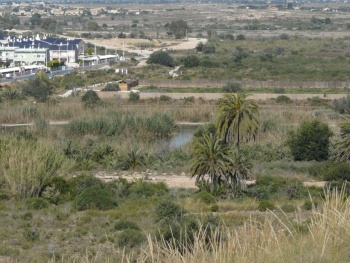
Mark Etheridge
A View over the entrance to the Clot de Galvany reserve on the Los Arenales-Gran Alacant road
Overview
The Clot de Galvany is a small but extremely interesting nature reserve sandwiched between the N-332 road and the twin urbanisations of Gran Alacant and Los Arenales just south of Alicante. It forms part of the wider area known as the Cabo de Santa Pola. There is a variety of ecosystems, from wetlands through Mediterranean scrub, pine plantations and rocky hillsides giving a wide diversity in a confined area. The main pool is known as the Charco de Contacto with a hide on the far side; alongside it is a recently-developed wader scrape also with a hide (known by some as the "Zeiss hide" after its sponsor). Further on there is another hide overlooking a seasonally marshy area, and further still there is another hide overlooking a pool which lies beneath the rocky hill to the west - this hide is however often locked up and this pool often dries out during drought conditions.
Birds
Notable Species
White-headed Duck and Marbled Duck breed on the reserve, as well as Purple Swamphen. Rufous Bush Robin can be found in the pines to the west in summer, and Wryneck and Iberian Green Woodpecker are present all year.
Rarities
A Baird's Sandpiper was reported in 2004; Green-winged Teal 2005, Pectoral Sandpiper 2006, Azure-winged Magpie in 2009.
Check-list
Little Grebe, Squacco Heron, Cattle Egret, Little Egret, Mallard, Common Pochard, Tufted Duck, Shoveler, Teal, Common Kestrel, Booted Eagle, Marsh Harrier, Common Moorhen, Eurasian Coot, Black-winged Stilt, Little Ringed Plover, Ringed Plover, Kentish Plover, Eurasian Golden Plover, Little Stint, Temminck's Stint, Common Snipe, Common Redshank, Common Greenshank, Marsh Sandpiper, Green Sandpiper, Wood Sandpiper, Common Sandpiper, Stone Curlew, Yellow-legged Gull, Common Swift, Pallid Swift, European Bee-eater, Eurasian Hoopoe, Lesser Short-toed Lark, Crested Lark, Eurasian Crag Martin, Barn Swallow, Red-rumped Swallow, Northern House Martin, Sand Martin, Meadow Pipit, Water Pipit, Spanish Yellow Wagtail, White Wagtail, Blue Rock Thrush, Eurasian Robin, Black Redstart, Common Redstart, Whinchat, European Stonechat, Northern Wheatear, Black-eared Wheatear, Black Wheatear, Cetti's Warbler, Zitting Cisticola, Savi's Warbler, Sardinian Warbler, Dartford Warbler, Blackcap, Common Chiffchaff, Willow Warbler, Firecrest, Spotted Flycatcher, European Pied Flycatcher, Woodchat Shrike, Southern Grey Shrike, Common Starling, Spotless Starling, House Sparrow, Chaffinch, European Serin, European Greenfinch, European Goldfinch, Eurasian Linnet}}
Other Wildlife
The area contains Ocellated, Red-tailed and Iberian wall lizards, Montpellier Snake, Field Mice and Pygmy Shrew. Rabbits are to be found in some numbers, providing a good food source for several raptors during the winter. There is an abundance of butterflies, including the Swallowtail, as well as several interesting beetle species. Unfortunately, mosquitoes breed in the damp patches and can be quite a nuisance at times.
Site Information
History and Use
In 1978 the Clot suffered severe damage through property developers unauthorised attempts to develop the area; serious drainage and earthworks took place which altered its unique natural features and functionality, these works were stopped by pressure from citizens and environmental groups. The area has now been taken over by the city council of Elche, which has taken active regeneration, conservation and educational measures to preserve the environment.
Areas of Interest
There are several former Spanish Civil War military bunkers around the reserve; it is not thought that these saw any action during the conflict.
Access and Facilities
The reserve entrance is from the El Arenales - Gran Alacant coast road opposite the junction with the Santa Pola coast road. There is a large parking and picnic area and an information centre. This is the only entrance - the rest of the reserve is now fenced off and other access gates are locked to deter dog-walkers, although holes through the fences do seem to appear with some regularity!
From the entrance, a main track takes you into the reserve, a walk of about 500 metres will bring you to the Charco de Contacto pool, and well-marked tracks radiate from here to pass throughout the reserve. They are popular with cyclists, joggers and other walkers, and it is possible to walk around the whole area on a circular route of about 5 Kms. The tracks are passable with care by those of limited mobility, but wheelchairs are not recommended for the longer and steeper tracks.
There are plenty of bars, shops and restaurants in the nearby urbanisations.
External Links
Content and images originally posted by Mark Etheridge




